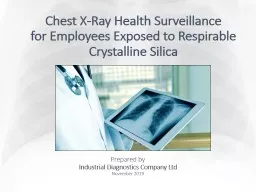

for Employees Exposed to Respirable Crystalline Silica Prepared by Industrial Diagnostics Company Ltd November 2019 In 2016 the HSE outlined their approach to the control of exposure to RCS at work ID: 930635
Download Presentation The PPT/PDF document "Chest X-Ray Health Surveillance" is the property of its rightful owner. Permission is granted to download and print the materials on this web site for personal, non-commercial use only, and to display it on your personal computer provided you do not modify the materials and that you retain all copyright notices contained in the materials. By downloading content from our website, you accept the terms of this agreement.
Slide1
Chest X-Ray Health Surveillancefor Employees Exposed to Respirable Crystalline Silica
Prepared byIndustrial Diagnostics Company LtdNovember 2019
Slide2In 2016 the HSE outlined their approach to the control of exposure to RCS at work
Estimated 800 people die each year - lung cancer caused by exposure to silica dust. 12,200 deaths per year - other workplace respiratory disease.World wide global estimate was 28,000 deaths per year
Slide3Bernardino Ramazzini (1713)
..maladies that attack stone cutter, quarrymen and other such workers…often breath in rough, sharp, jagged splinters…hence they are usually troubled with cough..asthmatic infections and become consumptive…when the bodies of such workers were
dissected they were found to be stuffed
with small stones
Slide4400
years later the HSE issued guidance on health surveillance for employees exposed to RCSIncluded the requirement for CXR to look for the small stones first identified in 1713
First CXR program in 2005 across 900 brick yard workers.
Since 2016 we have conducted over 6000 CXR’s on workers across high risk sectors identified by the HSE
2 consultant chest radiologists – now the most experienced experts in reading films to the ILO pneumoconiosis standard.
Slide5What is Silicosis?
Occupational Lung Disease resulting from inhalation of fine silica dust particlesRCS lodges in smallest part of lungsLungs become scarred (fibrosis)Breathing becomes impaired
Can be life threatening
Silicosis is a recognised OLD
Silicosis can increase the risk of lung cancer and COPD
Healthy Lung
Lung with Silicosis
Slide6Silicosis can also increase your risk of other serious and potentially life-threatening conditions, including:Tuberculosis (TB) and other chest infectionsPulmonary Hypertension
ArthritisHeart FailureKidney DiseaseChronic Obstructive Pulmonary Disease (COPD)Lung Cancer
Further Problems
Slide7Incident Figures
According to the Industrial Injury Disablement Benefit (IIDB) Scheme there were:
95 cases of Silicosis in 2007
85 cases of Silicosis in 2008
14
deaths
from Silicosis in 2006
7 deaths
from Silicosis in 2007
HSE have stated that 5 in 100 lifetime risk (45 years) at 50% of the WEL (0.05mg/m3) or 30 in 100 at the WEL (0.1mg/m3)
HSE have stated exposure to RSC increases lifetime risk of lung cancer in males from 8 in 100 to 13 in 100
Slide8HSE Guidance
January 2016www.hse.gov.uk/pubns/indg463.pdf
HSE Defined
High-Risk Occupations to be Considered for Health Surveillance
Construction
Foundry Work
Brick Work
Tile Work
Ceramics
Slate
Manufacturing
Quarries
Stone Work
Service schedule:
Annual Respiratory Health Surveillance
Baseline, (1 year repeat), 15 year CXR, 3 yearly repeat CXRs (after 15 years exposure)
Slide9Slide10RCS Health Surveillance
Employer’s responsibility to consider a chest X-ray programMost implement at 50% of the WEL (5 in 100 lifetime risk) High Risk25% of WEL Medium Risk10% of WEL Low RiskMost consider previous exposure, if still exposed
Best practice
demonstrated by following HSE guidance
Chest X-rays agreed as the only definitive method of fine opacity (Silicosis) identificationStill a requirement for Respiratory Health Questionnaire and Spirometry (lung function tests)
annually
Slide11Normal Chest X-Ray
Early / Mild Silicosis
Slide12Three Stage Pathway
A chest X-ray is a powerful screening tool but does
NOT
provide a definitive diagnosis of silicosis alone
Three Stage Pathway
to positively identify and manage cases of silicosis
Chest X-ray Screening
Second Opinion via the Multi-Disciplinary Team (MDT)
Further investigation including CT scan via Occupational Lung Disease Centre or NHS respiratory specialist to provide diagnosis
Slide13Outcome Pathways
Stage 1 - Screening
1 month from referral to report
Slide14Onward Referral Management
STAGE 2 – Second Opinion
Slide15Onward Referral Management
STAGE 3 – Occupational Lung Disease Centre
Occupational Disease Centre (ODC) Referral:
Referral to regional Specialist Occupational Disease Centre
Via GP or direct access referral
Aberdeen
Birmingham
Liverpool
London
Manchester
Newcastle
Nottingham
Sheffield
Slide16STAGE 3 – Occupational Lung Disease Centre
8 weeks after referral
Slide17Benefit to Health
Detailed image taken of entire chest
Early detection of
ALL AND ANY
abnormalities Appropriate onward referral for medical advice and attention
Benefit to
health
and life expectancy
for occupational and non-Occupational Lung Disease
Medical Findings include:
CA Lung
Paralysed diaphragm
Collapsed lung
Emphysema
Coincidental findings:
Dextrocardia, foreign bodies, fractured ribs
Slide18Total number for CXR
Total number complete pathway
Total referred to MDT
Total CT
Total confirmed cases67415645166
85
10
100%84%
2.9%
11.8% (0.015% of complete pathways)
0.18%
Global Silicosis and Serious Disease cases to date
Total number for CXR
Total GP
2WW
Cardiomegaly
Emphysema
Collapsed lung
Enlarged heart
Clinical
Correlate
6741
751
81
29
32
15
4
22
100%
11%
11% (1.2%)
2.9%
(0.4%)
4.26%
(0.5%)
2% (0.035%)
0.53% (0.05%)
2.93% (0.32%)
Slide19Largest cohort of currently exposed employeesIncidence of disease in “newer” employees (exposed since controls introduced)
Research Into Occupational Lung Disease
- Consent taken at the point of X-ray
- Industry and exposure level against CXR results
- Control for smoker incidence
This service will generate data that is of significant future importance
Consent sought for research for all participants
Slide20Thank you!
Contact:Industrial Diagnostics Company Ltd.Carrie Cashmore, Imaging Services Managerimaging@industrial-diagnostics.com
08450 775512